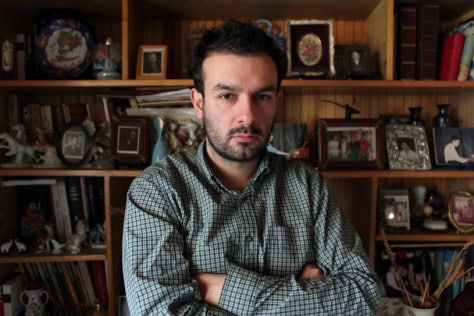A mere three super limited releases (try 100 pressings per 12″) into their career as Cage & Aviary, the London duo is already riding high on the hype horse thanks to a licensing deal with our heroes at DFA and massive amounts of blogosphere discussion.
Nigel and Jamie, the two chaps behind instant classics like “Television Train” did a little interview with us a while back and got together a killer 90-minute mix that we're planning on bogeying through the week to. Download the MP3 below or stream it in the media player to the right as you enjoy delving into their back story.
One's and Two's – Cage & Aviary Mix (MP3)
I'm curious curious about how you make your music, so let's start with that stuff. Firstly, your vocals are totally awesome; it sounds as though you're Mark E. Smith doing disco cuts or something. Why do you sing like that?
Nigel: We spend a lot of our time in studio listening to great tracks: on a vocal tip Jamie introduced me to Arthur Russell's music and Laurie Anderson's stuff last year, and Another Green World by Brian Eno is an album we both love. On our track “Television Train” the lyric came fairly easily after we had been playing with production ideas for a few weeks. I'm into John Cooper Clark's stuff, tracks like “Post War Glamour Girls” and “I Don't Wanna Be Nice”, that kind of laconic delivery and I think I was channeling some Mancunian mid 80s new wave vibe that day.
Jamie: I'm not really a singer, as you'll hear in some of our forthcoming releases
Most of your songs (if not all of them) are pretty epic in ambiance. They sound really vast, really cinematic. How do you write the tunes and what do you think gives them this bigness?
Jamie: Value for money? We like to give good music minutes per record… to be honest we don't try to make them sound vast, it's probably down to Nigel's melodies and my penchant for long arrangements. The groove is actually the main thing we aim for, but sometimes it just turns into something else. We are working on some new material that is more stripped, more basic, and shorter (!), with those great early Chicago house tracks in mind―our forthcoming release on Tiny Sticks hints in that direction too.
To help answer that question, I'll take an example. Often times, your guitar hooks remind me of something that say, New Order would make… but your bass lines are super funky and thick. To me, there's a tension in your music.
Jamie: well we're both massive fans of the white-boy funk I guess, bands like A Certain Ration, Material, New Order, and of course Talking Heads and Tom Tom Club. So I guess the tension is funk having a dance-off with punk at the Paradise Garage, but then heading home for a threesome with rock and giving birth to house. Or something.
You've release only three 12″s yet you've managed to get quite a bit of traction on the blogs and have been doing some remixes, too. What do you credit this success to?
Jamie:I think a lot of it is down to Television Train grabbing the attention, it seems to have an appeal beyond it's ltd release numbers – and the DFA license of it is an interesting hook to write about for the bloggers. The remix series is self-propelled, we took it upon ourselves to contact the six artists involved and we're releasing them on our own label, The Walls Have Ears. I've always loved those early 12″ remix records from the 70s and 80s with a vocal remix on the a-side, and a dub-out on the flip, and that's kinda where the idea came from.
Jamie, you've been doing house sort of stuff for a while now, if I'm not mistake; Nigel, you'd been doing rockier stuff before Cage & Aviary. What brought you together and how do you benefit from your different backgrounds?
Nigel: Jamie and I kept bumping into each other at nights he was playing and random events and it seemed like a good idea. Cage & Aviary provides a place for experimentation that I don't have in other parts of my musical life. I don't quite understand what I'm doing when we are making our tunes which is great. I bring a lot of melodic ideas and hooks to the party which come from my indie background.
Jamie: The dynamic works very well, I have nothing to compare it with as I've never made music before, but it feels right. I feed Nigel with leftfield space disco nuggets and we go from there…
Considering that your releases are incredibly limited in quantity, how do you sustain the duo? Do you have a lot of concerts? DJ gigs? What keeps you going?
Jamie: I DJ a bit, but we're not doing gigs together as yet―we are getting that together at the moment, and the first few sessions felt great. There's definitely a spark between me DJing, and Nigel playing along, especially when I'm mid-mix, or have two loops going, and Nigel vibes on it – then it becomes something brand new and exciting. You may get a sneaky peek into this world very soon…
Nigel: I make my money from session/production work and songwriting assignments. My local undertaker has just hired me to write some songs about his business: I am not lying. We are putting our live set together now and making inroads into our backlog of unfinished tracks.
Whenever I ask someone why they think disco is making somewhat of a “comeback” (or at least coming back into the pop world and loosing its obscurity), I get a different answer. What draws you to the [incredibly broad] genre?
Nigel: Girls
Jamie: I got into disco in the mid-90s, after getting very bored and disheartened with house music. I never realized how much house owed to disco―when I bought Ride On Time by Black Box at the age of 17 I didn't have a clue that it sampled some black disco diva called Loleatta Holloway. Years later I discovered these roots of house, and that was a really amazing ride. So, it's never really gone away has it?
Oh, and girls.
 Q&A with Larry Gus
Q&A with Larry Gus We Own the Night: The Edison
We Own the Night: The Edison
No Comments